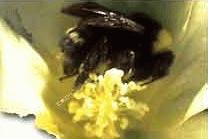Bumble Bee Gallery
Bumble Bee Publications
 Bumble bees (Genus Bombus) are semi-social bees with some similarities to the honeybee. Bumble bees have a queen that produces drones, workers and other queens. However, the colonies are annual, unlike the honeybee’s year-round colonies. Queens emerge from their winter resting stage, called diapause, each spring and begin foraging for nectar and pollen. Bumble bees hold pollen on their hind legs like the honeybee. The queen uses the collected pollen and nectar to rear workers.
Bumble bees (Genus Bombus) are semi-social bees with some similarities to the honeybee. Bumble bees have a queen that produces drones, workers and other queens. However, the colonies are annual, unlike the honeybee’s year-round colonies. Queens emerge from their winter resting stage, called diapause, each spring and begin foraging for nectar and pollen. Bumble bees hold pollen on their hind legs like the honeybee. The queen uses the collected pollen and nectar to rear workers.
Worker bees are non-reproductive females. Once the new workers begin to forage, the queen stops foraging and stays in the nest to produce more brood. The workers feed and care for the developing brood. During this period of time, when workers care for larvae and a division of labor exists, the colonies are considered “social.” Towards the end of summer the colony begins to produce reproductive queens and drones. When these reproductives mature, they leave the colony and mate. The new queens then find a suitable overwintering site and go into diapause over the winter.
Bumble bees form their colonies in existing cavities. Depending on the species, they may inhabit abandoned rodent nests or cavities in logs. There are about 30 species in North America, and at least two have been domesticated for use in agriculture. New technological developments have made colonies available on a year-round basis. In western North America, Bombus occidentalis is the native bee that is available as a pollinator. In the east, Bombus impatiens is available as a pollinator. Bumble bees are currently used commercially for pollination of greenhouse tomatoes and peppers.
The bumble bee is an excellent pollinator in a greenhouse environment. The colonies are housed in a box with a small opening which allows the bees to enter and exit. Colonies consist Of 100-200 workers and a queen. In tomatoes, it is possible to achieve nearly 100% pollinated flowers with bumble bees. Research has shown that bumble bees are also effective pollinators of orchard crops such as almonds, apples and cherries.
Bumble bees do not produce harvestable quantities of honey, but they do store a small amount to sustain themselves for short periods of environmental adversity.
References
Heinrich, B. 1979. Bumble Bee Economics. Harvard University Press, Cambridge, Massachusetts. 245 pp.
